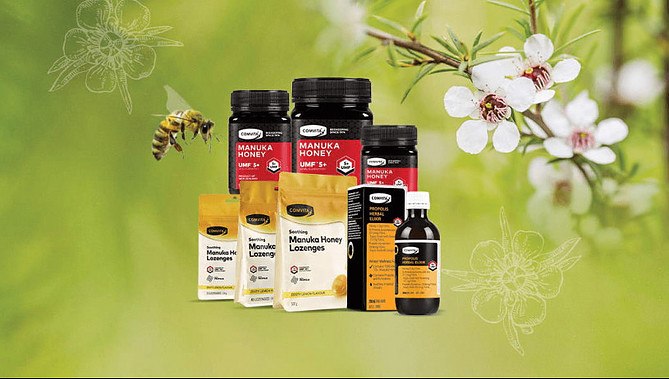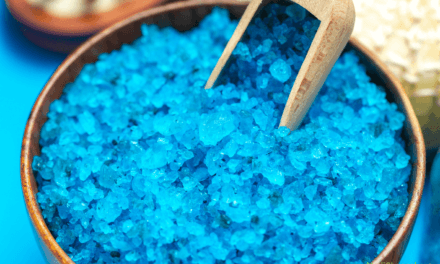This Comvita Manuka Honey Review will look into the Manuka Honey product range of COMVITA®. Regardless of the brand, this is also a guide to anyone interests in considering Manuka Honey to find out how effective and safe they really are…
Let’s begin…
Are you one of those that have been using honey as a natural sweetener to add taste to our teas, coffee, oatmeals, smoothies and pancakes? Or are you among those that use it for its healing properties to treat skin conditions like burns, wounds and even to improve acne? If you are in any of the groups and have not tried manuka honey, then you may be missing out.
Most people, just as I once did, believe that all honey is the same. But have you stopped to ask why some honey are lighter, darker, thicker, sweeter or slightly bitter than others and to top it all some honey are very pricier than the others, even those from the same brand? This is to tell you that not all honey is the same.
There are different types of honey depending on the region and the type of plant nectar the bees feed on before producing the honey. This also determines the antimicrobial and anti-inflammatory quality of the honey.
Unlike your regular honey, manuka honey is a honey with a difference. Those that have used it can testify to that.
What is Manuka Honey?
Manuka honey is honey obtained from bees that feed on the nectar of the Manuka plant (leptospermum solarium), a shrub native to New Zealand and Australia.
What makes this honey special and different from other types of honey is its higher medicinal properties which steam from the higher concentration of methylglyoxal (MGO).
Methylglyoxal (MGO) is the active ingredient in manuka honey that gives its anti-inflammatory, antibacterial, antifungal and antioxidant properties.
Secondly, while most types of honey lose their antibacterial properties when processed with heat, manuka honey still retains most of its antimicrobial quality. It is lighter in colour, has a thicker consistency, with a unique aroma and taste that is slightly bitter.
The three main ingredients in manuka honey are
- Methylglyoxal (MGO)
MGO contains the antimicrobial and anti-inflammatory properties
- Leptosperin
It is a natural occurring chemical compound in manuka plants and is only found in manuka honey.
Leptosperin cannot be created artificially and is a very important component in manuka honey as its presence indicates that the manuka honey is genuine.
- Dihydroxyacetone (DHA)
DHA indicates the age of the honey.
It also contains minerals, vitamins and amino acids.
Just as raw honey is regarded as a superfood, manuka honey is not only delicious and healthy but also good for skin care.
It contains a higher level of anti-inflammatory and antibacterial properties. It helps to improve digestion, promote the healing of wounds, boost immunity, ease stomachache and relieves sore throat.
It moisturizes the skin and promotes a clean and smooth skin as it fights acne-causing bacteria and reduces inflammation. It also slows down ageing.
Health Benefits of Manuka Honey
The potential health benefits of manuka honey include the below.
- Promote wound healing
Due to its antibacterial and anti-inflammatory properties, there is scientific evidence that manuka honey may promote the healing of wounds like burns, boils and foot ulcers by speeding up the regeneration of tissue.
This can be of great benefit to diabetic patients with foot ulcers, as study has shown that manuka honey impregnated dressings (MHID) can be used to effectively treat, disinfect and promote the fast healing of neuropathic diabetic foot ulcers (NDFU).
- Reduce cognitive ageing
Manuka honey, like other types of honey, acts as a therapeutic antioxidant. It helps to reduce oxidative stress and improve cognitive function, and cognitive ageing which increase the risk of dementia
in the aged.
- Blood pressure support
Manuka honey helps to lower blood pressure and improve the circulation of blood.
- Promote oral health
Manuka honey can help to keep your mouth and gum healthy and effectively inhibit the growth of harmful oral bacteria like A. actinomycetemcomitans and P. gingivalis which are associated with tooth decay, inflammation of the gum and plaque formation.
- Soothe sore throat and the common cold
Recent research carried out on head and neck cancer patients undergoing chemotherapy revealed that the consumption of manuka honey is effective against streptococcus mutans, a bacteria that causes sore throat.
- Use for treating skin conditions
May treat skin conditions such as acne, eczema, dry skin, and psoriasis.
How is Manuka Honey Graded?
Unique Manuka Factor
The highest and best scale for grading the potency of manuka honey by honey producers is known as Unique Manuka Factor (UMF). UMF is a quality trademark given to registered beekeepers and genuine producers and exporters of manuka honey.
UMF reflects the quantity of the 3 major ingredients found in specific manuka honey. UMF reflects the authenticity, quality and level of purity of the manuka honey.
The rating rate is from 5+ to 25+. The higher the UMF rating, the more the purity, the more antibacterial activity it has and the more potent it is.
For manuka honey to be considered to be potent enough for therapeutic purposes, it has to have a minimum UMF rating of 10+ (UMF 10+).
The strength and dosage of manuka honey to be taken depends on what you intend to treat.
- 5+ to 9+
This range is good for general well-being.
- 10+ to 15+
This range is good for therapeutic purposes.
Ideal for boosting the immune system, improving digestive and respiratory tracts and for healing wounds and burns.
- 15+
The highest quality honey is ideal for oral hygiene and treating wounds.
MGO Rating
Methylglyoxal (MGO) rating is another trusted grading system that measures the strength of the antimicrobial properties of the manuka honey.
MGO concentration is directly related to the UMF rating of the manuka honey. The higher the concentration and rating, the better the quality and potency of the product.
Below is a table of a correlation between UMF Rating and the MGO concentration range of manuka honey.
|
UMF Rating |
MGO Concentration Range (mg/kg) |
|
UMF 5+ |
83-100 |
|
UMF 10+ |
263 |
|
UMF 12+ |
354-400 |
|
UMF 15+ |
514-550 |
|
UMF 18+ |
692 |
|
UMF 20+ |
829 |
K-factor Rating
Also, there are brands of manuka honey that are labelled using the grading system of K-factor. This is the least dependable grading system.
It does not authenticate the purity, potency or genuineness of the product.
You can use such brands only as natural sweeteners without expecting any medicinal benefits.
Now, let’s turn on the safety of using manuka honey…
Safety and Precautions
Manuka honey is generally safe for consumption but should be avoided or only taken after due consultation with your doctor.
If you have any of the following conditions, you must consult your doctor before adding manuka honey to your lifestyle.
- You are diabetic
Manuka honey, like every other type of honey, is high in natural sugar and can cause a spike in your blood sugar level, just as refined sugar does.
- You are allergic to bees or any other honey
- For infants below the age of one
Honey is not recommended for babies below the age of one due to the risk of foodborne diseases known as infant botulism.
Now, with the above knowledge about Honey and Manuka Honey, let’s turn on to Comvita Manuka Honey…
Comvita Manuka Honey Review
Comvita, one of the most trusted global producers and leading manuka honey brands in New Zealand. They have been into beekeeping since 1974.
Comvita has been licensed by the Unique Manuka Factor Honey Association (UMFHA) with Licence Number 1019. It has been a member of UMFHA for more than 18 years.
As one of the most reputable GMO and UMF certified manuka honey producers, they strictly adhere to UMF Golden Standard. This implies that their brand of honey is guaranteed as 100% genuine and obtained from a sustainable source.
Comvita is also Good Manufacturing Practice (GMP) certified by the New Zealand Ministry of Health and the Australian Therapeutic Goods Association for therapeutic products.
Every batch of Comvita honey is independently tested in accredited laboratories to guarantee its ratings, and they all come with a scientific certification of origin. Also, to assure you that this is the real deal, every batch of their honey can be traced back to the original hive.
Unlike most brands that pasteurize their honey, Comvita’s Manuka is raw, unpasteurized and gluten-free. So that people with gluten allergies can consume or apply it.
Nutritional Content of Comvita Manuka Honey
| Nutritional information Serving size: 10g |
Quantity per serving |
|
Energy |
137 KJ (33kcal) |
|
Carbohydrate |
8 g |
|
*Sugars |
7.8 g |
|
Protein |
Less than 1 g |
|
Total Fat |
Less than 1 g |
|
*saturated fat |
Less than 1 g |
|
Sodium |
Less than 5 mg |
Comvita Manuka Honey Products Range
Convita offers a range of manuka honey products.
They include;
1. Multifloral Manuka Honey
It is known as Comvita Manuka Blend Honey.
This is a natural blend of New Zealand honey, obtained when bees feed on the nectars of different floral plants. This range of products contains a blend of local honey, including manuka honey with a guaranteed level of Methylglyoxal (MGO) activity and other rich varieties of herbaceous honey such as Rewarewa and Kamahi.
This range of products is smooth, creamy with a flavour that is slightly milder than the Comvita UMF manuka honey range of products is available as
- Manuka Blend Honey – comes in a bottle of 250g, 500g and 1kg
- Manuka Blend Honey MGO 30+ – comes in bottles of 250g and 500g
2. Monofloral Manuka Honey
It is exclusively obtained from bees that feed on manuka bush.
This range of Comvita Manuka Honey is available in UMF grades of 5+, 10+, 15+ 18, 20+ and the reserved grade of 25+.
Each grade indicates the increasing Methylglyoxal (MGO) content and level of scarcity due to crop yields.
The higher the grade, the higher the therapeutic benefits.
- UMF 5+. Comes in bottles of 250 gram (8.8 oz) or 500 gram (17.06 oz) or 1 kilo (35.02 oz)
- UMF 10+. Comes in bottles of 250 gram (8.8 oz) or 500 gram (17.06 oz)
- UMF 15+. Comes in a bottle of 250 gram (8.8 oz)
- UMF 18+. Comes in a bottle of 250 gram (8.8 oz)
- UMF 20+. Comes in a bottle of 250 gram (8.8 oz)
The higher UMF levels of the Manuka honey, the darker color it is and the more distinctive its taste.
Pros
- UMF-certified
- Non-GMO and Gluten-Free
- Halal, and Kosher certified
- Each batch of honey can be traced back to the beehive
Cons
- This brand of manuka honey is pricier than others.
- A distinctive taste that may be too strong for some people
Conclusion
If you are one of those people who are not only looking for a brand of manuka honey not only as a natural sweetener but for its medicinal value, Comvita manuka honey is the way to go!
You can confidently choose from any of the wide range of Comvita manuka honey products if you need manuka honey
- as a sweeter,
- to boost your immunity,
- to improve your oral health or digestive disorders,
- to soothe your sore throats,
- to speed up wound healing or
- as a home remedy for acne.











